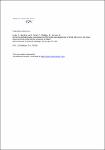Second external quality assessment of the molecular diagnostic of West Nile virus: Are there improvements towards the detection of WNV?
Linke, Sonja
MacKay, William G.
Scott, Calum
Wallace, Paul
Niedrig, Matthias
Background: WNV epidemics occur worldwide, new WNV isolates were isolated in southern-east Europe belonging to WNV lineage 2. A first international proficiency study on WNV indicted that some laboratories were not able to detect WNV lineage 2 virus genome by their PCR diagnostic assays. Therefore an actual External Quality Assessment with both virus lineages was performed to monitor the improvements in molecular diagnostics. Objectives: To asses the proficiency of laboratories to detect West Nile virus with molecular diagnostic tests. Study design: A test panel of different WNV isolates and virus dilutions was given to 26 laboratories to test the samples with their routine diagnostic methods. Results: Twenty-one participating laboratories provided 28 data set results. WNV lineage 1 was detected with high overall efficiency of 92% (67.9–100%) but two different WNV lineage 2 strains were detected at lower rates (mean = 73%, 67.9–75%) by the different PCR assays. 93% of the laboratories were able to detect a WNV lineage 1 with a concentration of 1.2 × 104 copies/ml but the detection rate was decreased to 68% for 1.2 × 103 copies/ml. One laboratory generated false-positive result from the non-virus control samples and 29% of the datasets showed false-positive results for non-WNV flavivirus samples. Conclusions: The WNV EQA showed an improved proficiency of laboratories as compared to the first EQA. However, the data suggest that problems in the detection of both lineages were still present since the first proficiency test was performed in 2006. Further proceedings versus the detection of both lineages are needed particularly for in-house assays.
Dateien zu dieser Publikation
Keine Lizenzangabe

